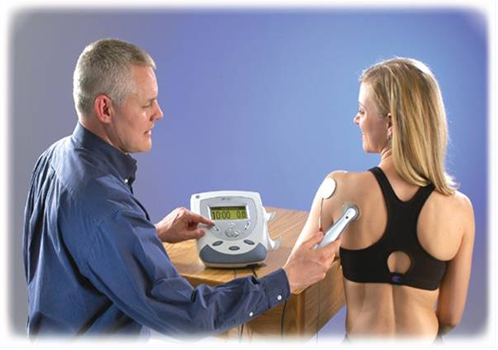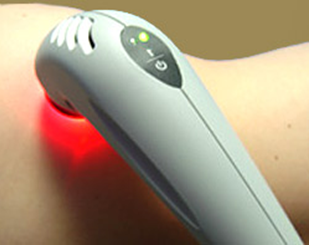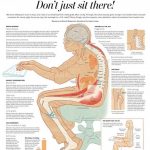Cold Laser Therapy
____________________________________________
Cold Laser Therapy or Low Level Laser Therapy (LLLT) is a treatment that utilizes specific wavelengths of light to interact with tissue and is thought to help accelerate the healing process. It can be used on patients who suffer from a variety of acute and chronic conditions in order to help eliminate pain, swelling, reduce spasms and increase functionality.
How Cold Lasers Work
Cold lasers are handheld devices used by the clinician and are often the size of a flashlight. The laser is placed directly over the injured area for 30 seconds to several minutes, depending on the size of the area being treated and the dose provided by the cold laser unit.
During this time, the non-thermal photons of light that are emitted from the laser pass through the skins layers (the dermis, epidermis, and the subcutaneous tissue or tissue fat under the skin). This light has the ability to penetrate 2 to 5 centimeters below the skin at 90mw and 830 nm.
Once the light energy passes through the layers of skin and reaches the target area, it is absorbed and interacts with the light sensitive elements in the cell. This process can be compared to photosynthesis in plants – sunlight is absorbed by plants, which is then converted to usable energy so that the plant can grow.
When cells absorb this light energy, it initiates a series of events in the cell that is theorized to eventually result in normalizing damaged or injured tissue, a reduction in pain, inflammation, edema and an overall reduction in healing time by increasing intracellular metabolism.
Effectiveness of Cold Laser Therapy
For years, physicians have been using cold laser therapy on patients who are seeking effective, alternative methods for pain relief. Since 1967 there have been over 2,500 clinical studies published worldwide. Many of these studies are double-blinded, placebo-controlled and have demonstrated cold laser therapy to be a proven method for pain relief.
Indications for Cold Lasers therapy
Cold laser therapy can stimulate all cell types including muscle, ligament, cartilage, nerves, etc., so a number of conditions can be treated by cold laser therapy. Some of conditions that may typically be treated by cold laser therapy include:
- Arthritis pain
- Back pain
- Carpal tunnel syndrome
- Fibromyalgia pain
- Knee pain
- Neck pain
- Tendonitis
Laser therapy treatment is safe, painless and fast. Deep Tissue Laser Therapy treatments are administered in 5 to 10 minutes. Typically patients see results after 3 to 5 treatment sessions. Deep Tissue Laser Therapy utilizes your body’s own healing powers by stimulating celluar activity. Despite fast treatment times, laser therapy treatments initiate a healing process that continues to actively reduce inflammation for up 24 hours after treatment.
Combine unit with ultrasound therapy and Cold laser therapy : Synergy effect in treatment
Ultrasound therapy
___________________________________________________________

Ultrasound therapy is a treatment modality used to treat pain conditions, and to promote tissue healing. While ultrasound therapy is not effective for all chronic pain conditions, it may help reduce your pain if you have any of the following:
- Osteoarthritis
- Myofascial pain
- Bursitis
- Carpal tunnel syndrome
- Pain caused by scar tissue
- Phantom limb pain
- Sprains and strains
Types of Ultrasound Therapy
There are two main types of ultrasound therapy: thermal and mechanical. Both use sound waves generated through a transducer head (which looks a bit like a microphone) to penetrate soft tissues. The difference between the two types of ultrasound therapy is the rate at which the sound waves penetrate the tissues.
- Thermal ultrasound therapy. Thermal ultrasound therapy uses a more continuous transmission of sound waves. The sound waves cause microscopic vibrations in the deep tissue molecules, increasing heat and friction. The warming effect encourages healing in the soft tissues by increasing the metabolism at the level of the tissue cells.
- Mechanical ultrasound therapy. Mechanical ultrasound therapy uses pulses of sound waves to penetrate tissues. While this still has a minor warming effect on the tissues, it also causes expansion and contraction in the tiny gas bubbles of the soft tissues. This helps to decrease the inflammatory response, reducing tissue swelling and thus decreasing pain.
The type of ultrasound therapy you receive depends on your condition. If you have myofascial pain, or had a muscle strain or sprain that has not healed, your therapist will likely use thermal ultrasound therapy. If your pain is caused by scar tissue or swelling, such as with carpal tunnel syndrome, you may benefit more from mechanical ultrasound therapy.
How Ultrasound Therapy is Performed
Your therapist will select a small surface area to work on for anywhere from five to 10 minutes. Gel is applied either to the transducer head or to your skin, which helps the sound waves evenly penetrate the skin. During your ultrasound therapy treatment, your therapist will continually move the transducer head over and around the selected area.
Will I Feel Anything During Ultrasound Therapy?
Some people feel a mild pulsing during ultrasound therapy, while others may feel slight warmth in the skin. Don’t be surprised, however, if you feel nothing at all, apart from the cold gel on your skin. If the area being treated is especially sensitive to touch, you could possibly feel discomfort as the transducer head passes over. Ultrasound therapy, however, should not be painful.
Is Ultrasound Therapy Safe?
Ultrasound therapy is deemed safe by the FDA provided it is performed by a licensed person, and provided the therapist keeps the transducer head moving at all times. If the transducer head remains in one place for too long, there is potential to burn the tissues underneath, which you may or may not feel.
Ultrasound therapy should not be used on these body parts:
- Over the abdomen, pelvic regions or lower back in women who are menstruating or pregnant
- Over lesions, broken skin or healing fractures
- Around the eyes, breasts or sexual organs
- Over any areas with plastic implants
- Over or near areas with malignant tumors
- Over areas with impaired sensations or blood flow
Additionally, it not be used on people who have pacemakers.
At Dr Hoa Pain clinic we are using the Digital Ultrasound – Laser combine therapy .
Call us for further details on Digital Ultrasound – Laser combine therapy .





